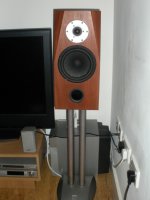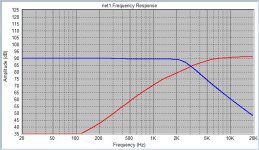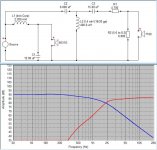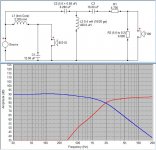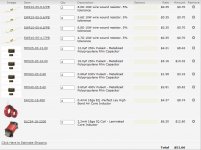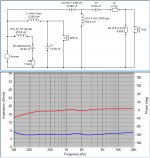Hello All
I'm posting this thread because I've just finished my DIY speakers and after a few teething problems I've just done a 2 and a half hour test including: Mozart - Requiem, Pink Martini - Sympathique, Beethoven - 9th Symphony, Martin Carthy & Dave Swarbrick - Life and Limb and finally Stevie Wonder - Songs in the key of life - all on CD of course, I'm only a youngster ;-)
So, how did I do it? I contact Neil Smith at Wilmslow Audio in the UK, got him to suggest some drivers, design a crossover and build me a stand-mount cabinet to suit. It cost about £200 (pre-veneered) and I was well happy.
Next I bought all the components. I got the best I could afford because I understood that this is a fairly crucial part of the speaker. I think I went overboard as I bought fancy Mundorf boutique caps, Duelund, stuff, etc. My advice to a new guy is DONT GO OVERBOARD. Remember, just because a professional has designed your crossover doesn't mean that YOU will like it. Try a few different designs & then buy fancy bits if you want to improve it.
One thing I noticed is - don't underestimate anything. The cost of things, the amount of time it will take or how much of something you may need. For example: internal speaker wire (hookup wire) - I bought 10 feet of some REALLY expensive wire, cut it all too short and wasted (ish) the lot. I ended up using some from Maplin that costed me about £2 for 20metres. Its fine and superb.
I would recommend getting the best drivers you can. I ended up with Scan-Speak D2904/7100 and 8531G00. I have to say the build quality is excellent. SHOP AROUND - I found mine at about £350 cheaper abroad than in the UK. They arrived in 2 days in perfect condition but BUDGET FOR IMPORT DUTY! I ordered nearly all my kit from the US and only got stung once.
An expense I didn't budget properly for was binding posts. I wanted something fancy and ended spending lots on WBT posts. In my opinion, unless you are an expert builder and have an AWESOME system (I don't... yet) then just get something that works. If you are not happy you can upgrade later.
So... I've rambled. What's my verdict... I've never heard anything like it. From a £19 DVD/CD player through a standard cable to a cheapo ebay amp to my £1800 speakers. I've nerver heard anything this good. Everything is so clear and the speakers 'throw' sound around the room. The bass is heavy but concise (I don't like boomy/strong bass) but the real fascinating bit is the high frequencies. Just amazing and crystal clear.
I'm now spending the next few weeks re-listening to my entire collection as I keep discovering things on tunes I've not heard before.
So, what do they look like? See attached. What do you think?
If anyone is interested in the design let me know
Cheers
Chris
I'm posting this thread because I've just finished my DIY speakers and after a few teething problems I've just done a 2 and a half hour test including: Mozart - Requiem, Pink Martini - Sympathique, Beethoven - 9th Symphony, Martin Carthy & Dave Swarbrick - Life and Limb and finally Stevie Wonder - Songs in the key of life - all on CD of course, I'm only a youngster ;-)
So, how did I do it? I contact Neil Smith at Wilmslow Audio in the UK, got him to suggest some drivers, design a crossover and build me a stand-mount cabinet to suit. It cost about £200 (pre-veneered) and I was well happy.
Next I bought all the components. I got the best I could afford because I understood that this is a fairly crucial part of the speaker. I think I went overboard as I bought fancy Mundorf boutique caps, Duelund, stuff, etc. My advice to a new guy is DONT GO OVERBOARD. Remember, just because a professional has designed your crossover doesn't mean that YOU will like it. Try a few different designs & then buy fancy bits if you want to improve it.
One thing I noticed is - don't underestimate anything. The cost of things, the amount of time it will take or how much of something you may need. For example: internal speaker wire (hookup wire) - I bought 10 feet of some REALLY expensive wire, cut it all too short and wasted (ish) the lot. I ended up using some from Maplin that costed me about £2 for 20metres. Its fine and superb.
I would recommend getting the best drivers you can. I ended up with Scan-Speak D2904/7100 and 8531G00. I have to say the build quality is excellent. SHOP AROUND - I found mine at about £350 cheaper abroad than in the UK. They arrived in 2 days in perfect condition but BUDGET FOR IMPORT DUTY! I ordered nearly all my kit from the US and only got stung once.
An expense I didn't budget properly for was binding posts. I wanted something fancy and ended spending lots on WBT posts. In my opinion, unless you are an expert builder and have an AWESOME system (I don't... yet) then just get something that works. If you are not happy you can upgrade later.
So... I've rambled. What's my verdict... I've never heard anything like it. From a £19 DVD/CD player through a standard cable to a cheapo ebay amp to my £1800 speakers. I've nerver heard anything this good. Everything is so clear and the speakers 'throw' sound around the room. The bass is heavy but concise (I don't like boomy/strong bass) but the real fascinating bit is the high frequencies. Just amazing and crystal clear.
I'm now spending the next few weeks re-listening to my entire collection as I keep discovering things on tunes I've not heard before.
So, what do they look like? See attached. What do you think?
If anyone is interested in the design let me know
Cheers
Chris
Attachments
Chris, I hate to say this when you seem to enjoy your new speakers. I looked at the crossover design you posted in your original build thread:
http://www.diyaudio.com/forums/showthread.php?t=150648
It seems that this crossover basically relies on textbook formulas and maybe some hand/ear tuning after that. It has virtually no baffle step compensation built in there. If you really enjoy it, I have nothing to say further. But if you've looked for good hi-fi speakers whose tonal balance is neutral and precise, then this crossover is not for you. You chose some of the best, cutting-edge drive units on earth, and used them in a primitive way. Don't you feel their midrange too forward and bright? If not, I'm out 😀
-jAy
http://www.diyaudio.com/forums/showthread.php?t=150648
It seems that this crossover basically relies on textbook formulas and maybe some hand/ear tuning after that. It has virtually no baffle step compensation built in there. If you really enjoy it, I have nothing to say further. But if you've looked for good hi-fi speakers whose tonal balance is neutral and precise, then this crossover is not for you. You chose some of the best, cutting-edge drive units on earth, and used them in a primitive way. Don't you feel their midrange too forward and bright? If not, I'm out 😀
-jAy
Hi Jay
I do enjoy the speakers but I'm only about 80% happy with them. They are definately better than anything I've ever owned or better than anything I've every auditioned BUT: I do feel as though I'm not getting the very best out of them.
What do you suggest to improve them? Is there any way of improving them without having to just 'throw away' the crossover components I've invested in. I don't mind adding to the crossover but would like to get some return on investment for what I've bought.
Suggestions are more than welcome :-D
Chris
I do enjoy the speakers but I'm only about 80% happy with them. They are definately better than anything I've ever owned or better than anything I've every auditioned BUT: I do feel as though I'm not getting the very best out of them.
What do you suggest to improve them? Is there any way of improving them without having to just 'throw away' the crossover components I've invested in. I don't mind adding to the crossover but would like to get some return on investment for what I've bought.
Suggestions are more than welcome :-D
Chris
Chris,
I usually do my full modeling by incorporating baffle step loss/diffraction and box simulation results into drive units' published infinte baffle measurements. But since I don't have much time these days, this time I simply worked with crossover filters' transfer functions using drivers' impedance data. This approach works pretty well particularly for one, like me, who does crossover simulations frequently. First, take a look at your original crossover's transfer functions:
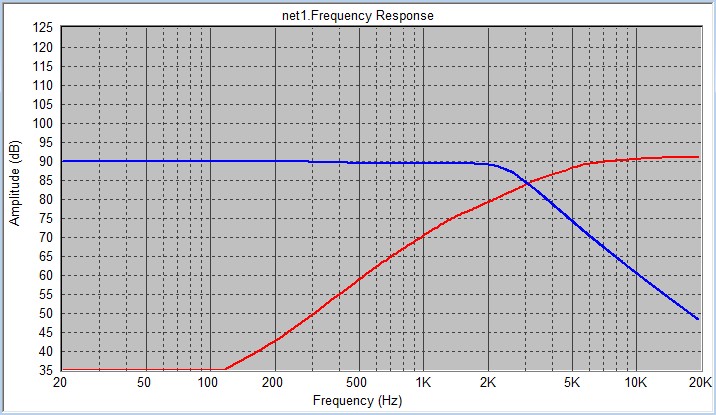
As you can see there's no baffle step compensation built into this crossover---no difference between 100 Hz and 1 kHz amplitude responses. This means that you hear less lower midrange and midbass than you need to. My predicted crossover frequency is around 3 kHz. The SS 7100 is a far better tweeter than many tweeters that could be crossed at 3 kHz.
Now take a look at Zaph's ZRT 2-way design's filter transfer functions:

Though his design uses a different tweeter (SS 6600), you get the idea. He compensated full 6 dB for the baffle step loss on the 8531G's response.
Finally, here is my suggested crossover and its filter transfer functions:
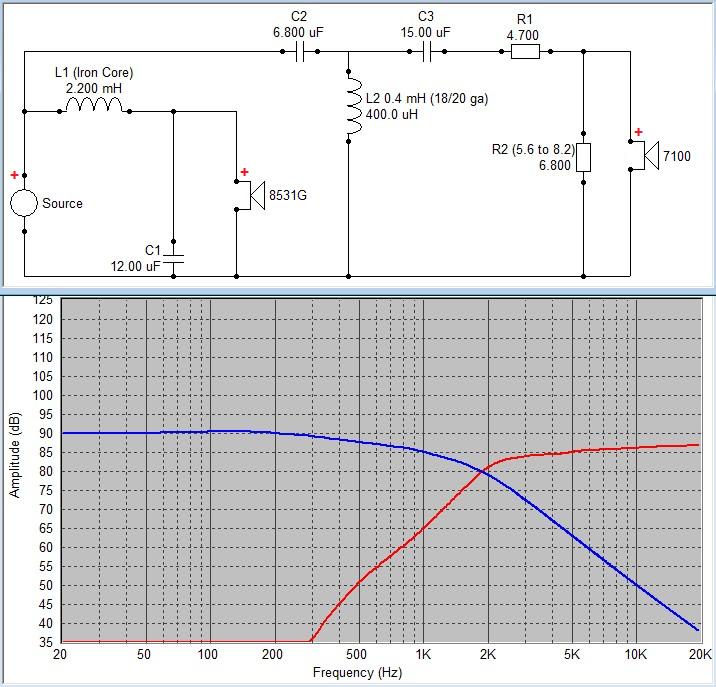
Mine has about 4-5 dB baffle step compensation, which will work in most listening rooms. The crossover point will be about 1.9 kHz. Note that the tweeter is wired in normal polarity (i.e., same polarity as the woofer is wired).
I provide a tweeter output adjustment option in case you need it. Replace the R2 resistor to increase or decrease the tweeter output. Default value is 6.8 ohm. A larger R2 value will increase the level and a smaller one will decrease it.
Here is my suggestion about crossover components. Rather than cannibalizing your current crossovers, I recommend purchasing inexpensive components to try the above crossover. Never use expensive components. 99.9 % of speaker system distortion is from drive units, not from crossover components. Simply use components of values and types specifed in my crossover schematic. Use iron core inductors for L1, and air core 18 or 20 gauge coils for L2. Use any inexpensive poly caps, and any resistors rated at 5 watts or greater. Is there any local or online store you can order these from?
If you like the new crossover, then you can cannibalize the previous ones and replace some parts with higher quality ones.
-jAy
I usually do my full modeling by incorporating baffle step loss/diffraction and box simulation results into drive units' published infinte baffle measurements. But since I don't have much time these days, this time I simply worked with crossover filters' transfer functions using drivers' impedance data. This approach works pretty well particularly for one, like me, who does crossover simulations frequently. First, take a look at your original crossover's transfer functions:
As you can see there's no baffle step compensation built into this crossover---no difference between 100 Hz and 1 kHz amplitude responses. This means that you hear less lower midrange and midbass than you need to. My predicted crossover frequency is around 3 kHz. The SS 7100 is a far better tweeter than many tweeters that could be crossed at 3 kHz.
Now take a look at Zaph's ZRT 2-way design's filter transfer functions:

Though his design uses a different tweeter (SS 6600), you get the idea. He compensated full 6 dB for the baffle step loss on the 8531G's response.
Finally, here is my suggested crossover and its filter transfer functions:
Mine has about 4-5 dB baffle step compensation, which will work in most listening rooms. The crossover point will be about 1.9 kHz. Note that the tweeter is wired in normal polarity (i.e., same polarity as the woofer is wired).
I provide a tweeter output adjustment option in case you need it. Replace the R2 resistor to increase or decrease the tweeter output. Default value is 6.8 ohm. A larger R2 value will increase the level and a smaller one will decrease it.
Here is my suggestion about crossover components. Rather than cannibalizing your current crossovers, I recommend purchasing inexpensive components to try the above crossover. Never use expensive components. 99.9 % of speaker system distortion is from drive units, not from crossover components. Simply use components of values and types specifed in my crossover schematic. Use iron core inductors for L1, and air core 18 or 20 gauge coils for L2. Use any inexpensive poly caps, and any resistors rated at 5 watts or greater. Is there any local or online store you can order these from?
If you like the new crossover, then you can cannibalize the previous ones and replace some parts with higher quality ones.
-jAy
Attachments
Last edited:
Hi Jay
Thanks for taking the time to write that; I really appreciate it. I'll order the new components over the next few days and give it a try.
There are no local shops that sell this kind of thing so I tend to order from Parts Connexion or Hificollective.
I noticed a problem with the speakers as they are set up last night. They hate low volumes currently. I get so much crackle and pop and loss of volume momentarily. Not happy...
Many thanks
Chris
Thanks for taking the time to write that; I really appreciate it. I'll order the new components over the next few days and give it a try.
There are no local shops that sell this kind of thing so I tend to order from Parts Connexion or Hificollective.
I noticed a problem with the speakers as they are set up last night. They hate low volumes currently. I get so much crackle and pop and loss of volume momentarily. Not happy...
Many thanks
Chris
Chris,
If you haven't ordered the components yet, here's a little better modeling result I obtained. For C2, wire 5.6 uF and 0.68 uF caps in parallel.
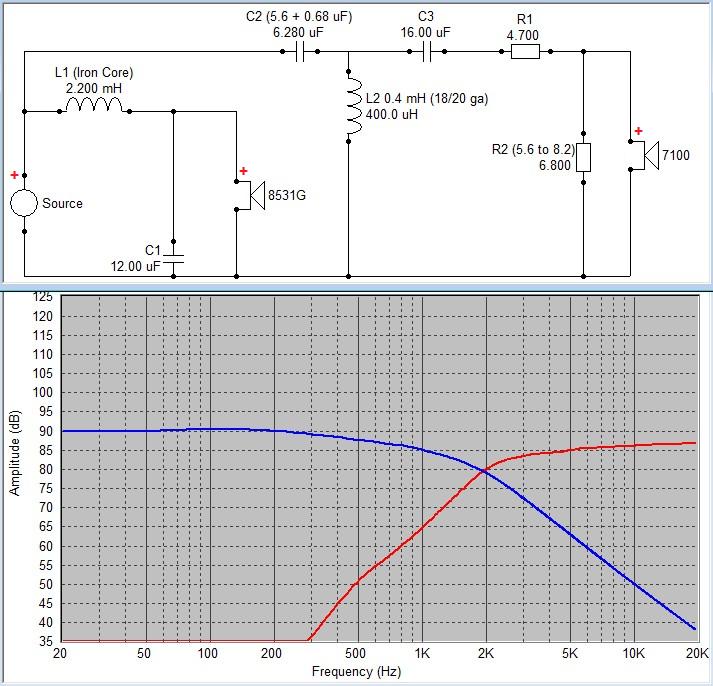
If you have to order online, here's a great solution for you. Use the Erse Audio online store (www.erseaudio.com). They manufacture crossover components in house. Outstanding quality components at great prices. You don't need Mundorf or Duelund parts. You can use as good components at a fraction of costs. Erse also charges only actual shipping cost. So no problem ordering internationally. Email and ask them to send them, for example, via USPS Priority Mail. Shipping won't cost a lot. See attached below for BOM I made for you. Only $52 for xover components for a pair of speakers. Isn't it sweet?
-jAy
If you haven't ordered the components yet, here's a little better modeling result I obtained. For C2, wire 5.6 uF and 0.68 uF caps in parallel.
If you have to order online, here's a great solution for you. Use the Erse Audio online store (www.erseaudio.com). They manufacture crossover components in house. Outstanding quality components at great prices. You don't need Mundorf or Duelund parts. You can use as good components at a fraction of costs. Erse also charges only actual shipping cost. So no problem ordering internationally. Email and ask them to send them, for example, via USPS Priority Mail. Shipping won't cost a lot. See attached below for BOM I made for you. Only $52 for xover components for a pair of speakers. Isn't it sweet?
-jAy
Attachments
Good. That's what I assumed. When you start building the crossovers, take a picture of your initial layout, and use Windows Paint to draw wiring including points to source and drivers. Post it here. Then I'll be able to let you know if anything's wrong or if there's a better inductor placement.
jAy
jAy
Just one more thing before I forget. When I made the BOM at Erse, I actually wanted to include 16 gauge IXQ steel laminate core inductors for L1 (2.2 mH), but found that it is currently out of stock. So I included the 18 gauge IQ steel laminates instead. When you contact the Erse, ask them if they can unwind IXQ 16 gauge 2.5 mH coils to 2.2 mH for you. Otherwise, if you are willing to spend a little more (only $13 more for a pair), use the Super Q 16 gauge. It's the best iron core inductor you can possibly get.
-jAy
-jAy
Jay that site you recommended is really good. I'll definately order my stuff from there in future. I'll get the Super Q 16 gauge.
I'll just have to count my pennies as I'm pretty broke after buying all the kit (I am building a Tubelab SSE too)
Thanks for your help so far though!
I'll just have to count my pennies as I'm pretty broke after buying all the kit (I am building a Tubelab SSE too)
Thanks for your help so far though!
You don't have to get the Super Q. The IXQ 16 gauge is more than sufficient. Ask them if they can unwind the 2.5 mH first.
And you're building the tube amp, too! In case you're not aware, this kind of tub amp has a low damping factor, or high output impedance, equivalently. Output impedance is usually 2 ohms. In this case, you won't get my designed frequency response due to the effect of the speaker's impedance swing. To avoid this problem, you need an impedance compensation circuit. Adding this filter will enable you to use the speakers with any amplifiers regardless of their damping factors. Take a look at the attched schematic for an added circuit and its effect on system impedance. Note that this LCR filter is placed before both low-pass and high-pass filters (that is, between amp and crossovers). Just use components I suggested there. Using more expensive parts in this circuit makes absolutely no difference in performance. For C5, use electrolytic caps, and for L5, use 20 gauge air cores.
And you're building the tube amp, too! In case you're not aware, this kind of tub amp has a low damping factor, or high output impedance, equivalently. Output impedance is usually 2 ohms. In this case, you won't get my designed frequency response due to the effect of the speaker's impedance swing. To avoid this problem, you need an impedance compensation circuit. Adding this filter will enable you to use the speakers with any amplifiers regardless of their damping factors. Take a look at the attched schematic for an added circuit and its effect on system impedance. Note that this LCR filter is placed before both low-pass and high-pass filters (that is, between amp and crossovers). Just use components I suggested there. Using more expensive parts in this circuit makes absolutely no difference in performance. For C5, use electrolytic caps, and for L5, use 20 gauge air cores.
Attachments
Last edited:
Excellent write up Chris! You have addressed the thing that I was most concerned about when I read one of your earliest posts, the amount of money you spent up front on crossover components!! 🙂
I've got a bunch of cheapish polyester (and shock horror) bipolar electros sitting in my cupboard for experimenting... Once I have something I like I'll consider buying something more expensive.
Jay has a point about BSC BUT it will depend a lot on the placement of the speakers, and not everyones tastes are the same. If you have your speakers close to the rear wall, then they will need less (or possibly no) BSC, if they are in the corners of the room it is even less lilkely, and if it is put in, could actually be detrimental.. FULL BSC is really only needed (as far as I am aware) if the speakers are in open space. Take this with a grain of salt as I'm going off research not practical experience 🙂
edit: and for the time being just enjoy your new creations, as you said they sound better than anything you have auditioned.. Id be saving my pennys for a decent source and amp before touching the speakers again personally (or consider building a gainclone). thats the problem with DIY, you will always feel like you could do better, sometimes we just have to accept what we have for a while and enjoy it 🙂
Tony.
I've got a bunch of cheapish polyester (and shock horror) bipolar electros sitting in my cupboard for experimenting... Once I have something I like I'll consider buying something more expensive.
Jay has a point about BSC BUT it will depend a lot on the placement of the speakers, and not everyones tastes are the same. If you have your speakers close to the rear wall, then they will need less (or possibly no) BSC, if they are in the corners of the room it is even less lilkely, and if it is put in, could actually be detrimental.. FULL BSC is really only needed (as far as I am aware) if the speakers are in open space. Take this with a grain of salt as I'm going off research not practical experience 🙂
edit: and for the time being just enjoy your new creations, as you said they sound better than anything you have auditioned.. Id be saving my pennys for a decent source and amp before touching the speakers again personally (or consider building a gainclone). thats the problem with DIY, you will always feel like you could do better, sometimes we just have to accept what we have for a while and enjoy it 🙂
Tony.
Last edited:
If you have your speakers close to the rear wall, then they will need less (or possibly no) BSC
Some amount of BSC is needed even for speakers on wall if the cabinet depth is several inches or greater. The reason is that baffle step loss starts at several hundred Hz, but the room boundary reinforcement kicks in mostly below 100 Hz in this case.
Last edited:
ok thanks Jay 🙂 as I said I'm only going off research 🙂 Hopefully before too long I'll have done some experimenting in this regard as well!
In the end I think a lot comes down to personal taste. I think it is interesting how when tone controls are available on an amplifier, multiple different people will set them in completely different ways, all other things being equal (I bypassed mine).
I do have lpads on the mids and tweeters on my 3 ways. The most interesting thing I found is that when I adjusted them for the flattest in room response at my listening position (with computer and a panasonic wm61a capsule) I thought that they sounded absolutely awfull. I went back to setting them by ear 😉 One of the things the mike measurements were showing me was the lack of bass (due to baffle step) I guess part of the problem was probably that I was just cutting the mids and tweeters uniformly ), whereas I really needed something a little more sophisticated.
Tony.
In the end I think a lot comes down to personal taste. I think it is interesting how when tone controls are available on an amplifier, multiple different people will set them in completely different ways, all other things being equal (I bypassed mine).
I do have lpads on the mids and tweeters on my 3 ways. The most interesting thing I found is that when I adjusted them for the flattest in room response at my listening position (with computer and a panasonic wm61a capsule) I thought that they sounded absolutely awfull. I went back to setting them by ear 😉 One of the things the mike measurements were showing me was the lack of bass (due to baffle step) I guess part of the problem was probably that I was just cutting the mids and tweeters uniformly ), whereas I really needed something a little more sophisticated.
Tony.
- Status
- Not open for further replies.
- Home
- Loudspeakers
- Multi-Way
- DIY 2-Way Speaker Review + Advice for Newbies!
